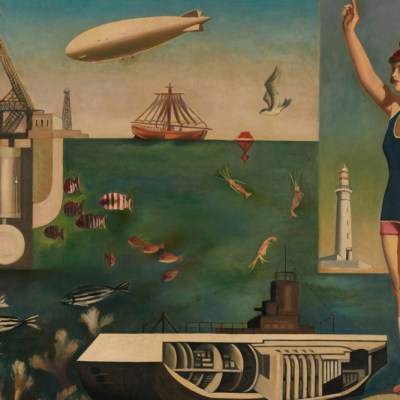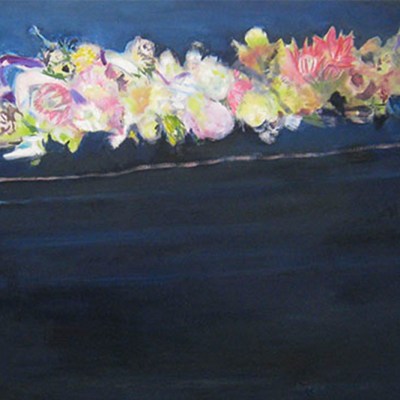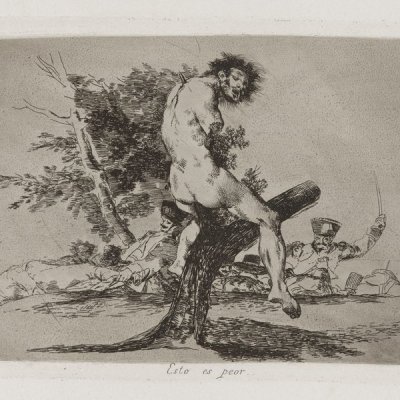From the April 2022 issue of Apollo. Preview and subscribe here.
Cecilia Alemani first saw the Venice Biennale when she was 22. It was, fortuitously, a good one: the Swiss curator Harald Szeemann’s ‘dAPERTutto’ in 1999. It ushered in the concept of a large-scale thematic show presented by a single director, alongside the pre-existing mish-mash of national pavilions, museum exhibitions and one-off shows that had characterised the previous 47 iterations. ‘I was very young, I didn’t even know if I wanted to be in the art world – and I was shocked by the sheer amount of things to see, the scale of the central exhibition and the fact that Szeemann’s show was so incredibly global. It had a huge impact on me,’ Alemani says.
Twenty-three years later, Alemani, now 45, is at the centre of the art world. An Italian based in New York, she is one half of a curatorial power couple with Massimiliano Gioni. He is the artistic director of the New Museum and in 2013 became the youngest-ever director of the Venice Biennale, at the age of 39. She is the director of the artistic programme at the High Line, a disused elevated railway snaking through the Meatpacking District and Chelsea that has been transformed into a public garden and sculpture park. She also organised Frieze Projects, the non-commercial programme accompanying the Frieze New York art fair, from 2012 to 2017, and Art Basel’s Cities project in Buenos Aires in 2018. And this year she too is director of the Venice Biennale.
Alemani is one of only five women to lead the Biennale so far. She has a reputation for commissioning emerging and critically acclaimed artists who can wow the public (since she started at High Line Art in 2011 she has worked with more than 350 artists, including Barbara Kruger, El Anatsui and Carol Bove). In 2017 she shook up the normally conservative Italian Pavilion in Venice, blacking out the cavernous industrial spaces and filling them with dramatic installations. One, by Roberto Cuoghi, created an X Files-like series of plastic tunnels, which he used as a workshop churning out sculptures of Christ.
The same year, she commissioned the African-American artist Simone Leigh to create the enormous bronze Brick House at the north end of the High Line near Hudson Yards. It was a 16-foot-high bust of a black woman whose skirt resembles a West African obus or clay house. Leigh was subsequently selected as this year’s incumbent of the United States Pavilion.
Cecilia Alemani photographed in New York in March 2022. Photo: Brad Ogbonna

Alemani is speaking in New York, shortly before travelling back to Venice to finalise the installation of her show. It has been dogged by logistical problems caused by the pandemic but, she says, the team’s biggest focus is now trying to make sure Ukrainian artists are able to take part, following the Russian invasion.
She says she guessed she might be in the frame for Venice when she picked up the phone at the end of 2019, and the caller was the outgoing Biennale president, Paolo Baratta. ‘I kind of knew because he just calls people out of the blue like that,’ she says. When he told her she had the job, she says, ‘For a few minutes I was ecstatically happy. And then it was like, holy cow, I have to do this and I have barely any time. The next morning I got up at six and started working.’
The lack of time to pull together a huge exhibition is just one of the many challenges Venice directors face. The exhibition’s title is another, and the butt of many insider jokes. Alemani has gone for ‘The Milk of Dreams’, a reference to a creepy children’s book from the 1940s by the Surrealist Leonora Carrington, who – in the decade after her death in 2011 – has returned to prominence. The book features a host of weird characters, among them children with wings for ears, a two-faced mustachioed man who eats flies and a machine-monster called Janzamajoria. ‘It’s a world of hybrid creatures, that can transform from human to animals and machines, a world in which everyone can become something else,’ Alemani says. It hints at an exhibition that puts identity, ecology, technology, the body and the irrational at its centre.
As it turned out, Alemani ended up with more time to plan ideas than she expected. Two months after she started work the pandemic struck, and for the first time since the Second World War the Venice Biennale was postponed. ‘It was a really weird beginning,’ Alemani says. ‘I’d got off to what I thought was a strong start. At that point, I thought: “Let’s use all this extra time to talk to artists, find out what they are doing.” Normally you just decide what you want to do and execute it, because there is no time to do anything else.’ Travel was out but, Alemani says, she spoke to ‘hundreds of artists’ and looked at their work over Zoom.
What emerged in this ‘confessional space’, as she puts it, were some common themes: ‘So many artists are challenging the centrality of the individual, the Renaissance and Enlightenment idea of man – a white, European man at the centre of the world. Our conflicted relationship with technology and our dependence on an ecosystem we seem set on destroying were other recurrent concerns.
‘That opened up the idea of featuring a majority of women and gender non-conforming artists, artists trying to portray a different universe, a more symbiotic, synergistic, sisterhood way of living together in this world,’ she says. Of the 213 artists and groups on show, around 90 per cent will be women, a record in the Biennale’s history. There are contemporary artists on show from 58 countries, including indigenous artists.
Installation view of Inner Earth (2018) by Delcy Morelos. Photo: Hendrik Zeitler; courtesy the artist

Alemani is at pains to point out she is not at the forefront of rewriting art history to recognise women and marginalised groups. Other exhibitions such as ‘WACK! Art and the Feminist Revolution’ (which toured the United States in 2007), ‘Radical Women: Latin American Art, 1960–1985’ (Hammer Museum and Brooklyn Museum, 2017/18) and ‘Fantastic Women’ (Schirn Kunsthalle and Louisiana Museum of Modern Art, 2020) have already started the process. ‘But you have to remember this show takes place in Italy, where attitudes are still pretty medieval,’ she says.
She also says the show will not be ‘political with a big P’: ‘Political issues are obviously present: but it’s less about big declarations and more about introspection, identity, the oneiric.’ It will also be a very ‘physical’ show, with a lot of painting, sculpture and installation, few screen-based works and no virtual or augmented reality. She cites the Colombian artist Delcy Morelos: she makes mazes out of earth, tobacco, cocoa powder, spices and coal, through which visitors can walk. They refer to Amazonian and Andean cultures and ecology, but are also a more odiferous and sensual take on Walter De Maria’s New York Earth Room (1977).
Unexpectedly for a show that is usually all about the art of now, there will also be work by around 90 historic artists, many from the early 20th century. Alemani says she wanted to include some older material at the outset – something she has done before. In 2010, at the five-yearly Greater New York survey at MoMA PS1, she showed four artists more associated with the 1970s and ’80s: Jack Whitten, Sylvia Sleigh, Judith Bernstein and Leslie Thornton.
But it was the pandemic that made it possible, giving her time to do the academic research and arrange museum loans. ‘I doubled up the exhibition,’ Alemani says, picking up on what she sees as the connections of contemporary artists to Surrealism, Dada, Futurism and the Bauhaus. These will be presented as five shows-within-the-show, focusing on female artists such as Eileen Agar, Georgiana Houghton, Leonor Fini, and Baya Mahieddine. Like Carrington, several are artists who were at the centre of artistic movements (Carrington was for some years in a relationship with Max Ernst) but were later largely forgotten.
Femme au panier et coq rouge (1947), Baya Mahieddine. Photo: Galerie Maeght, Paris

‘I told the contemporary artists I would have the historic works, but I didn’t show them lists or ask them to respond in any way,’ Alemani says. ‘I didn’t say, oh look, there’s a Leonor Fini that looks like your work. I’m not claiming that, say, Christina Quarles is influenced by Ithell Colquhoun. But I hope visitors will see, like me, similar methodologies tackling similar themes, 80 years apart.’
Mixing the contemporary with the historic is a difficult undertaking, as museums such as the Dulwich Picture Gallery found with its Twombly and Poussin show in 2011. Just as hard is welding together more than 1,400 works of art – many of them newly commissioned – by a culturally diverse group of artists into a coherent show.
The Venice Biennale’s historic industrial spaces present another challenge. The budget of €18m, meanwhile, is large but less than half that of the comparable German exhibition Documenta.
It is always risky to judge a Venice Biennale by the director’s pre-show press conference. Okwui Enwezor’s 2015 edition promised a tedious Marxist lecture but delivered beautiful, powerful galleries. Christine Macel’s 2017 show, by contrast, had conjured up a magical, meditative take on contemporary art but was at best hippyish and well-meaning.
But the times may be on Alemani’s side. There has been a two-year absence of big, exciting international shows: critics, curators and art-lovers are hungry for ideas. And although auction houses have done well selling art online, the primary galleries have struggled commercially without physical places to show off artists’ work. The Venice Biennale is not just the most high-profile art show, it is the biggest marketing event on the planet for living artists.
Alemani has shown she has an eye for spotting rising talent and a finger on the pulse of contemporary themes. She has demonstrated she can commission attention-grabbing works that please the public and critics alike, and handle difficult industrial spaces. She has a less recent record of staging large-scale, multi-artist thematic exhibitions. But the director of this year’s Venice Biennale has most of the art world rooting for her.
From the April 2022 issue of Apollo. Preview and subscribe here.



